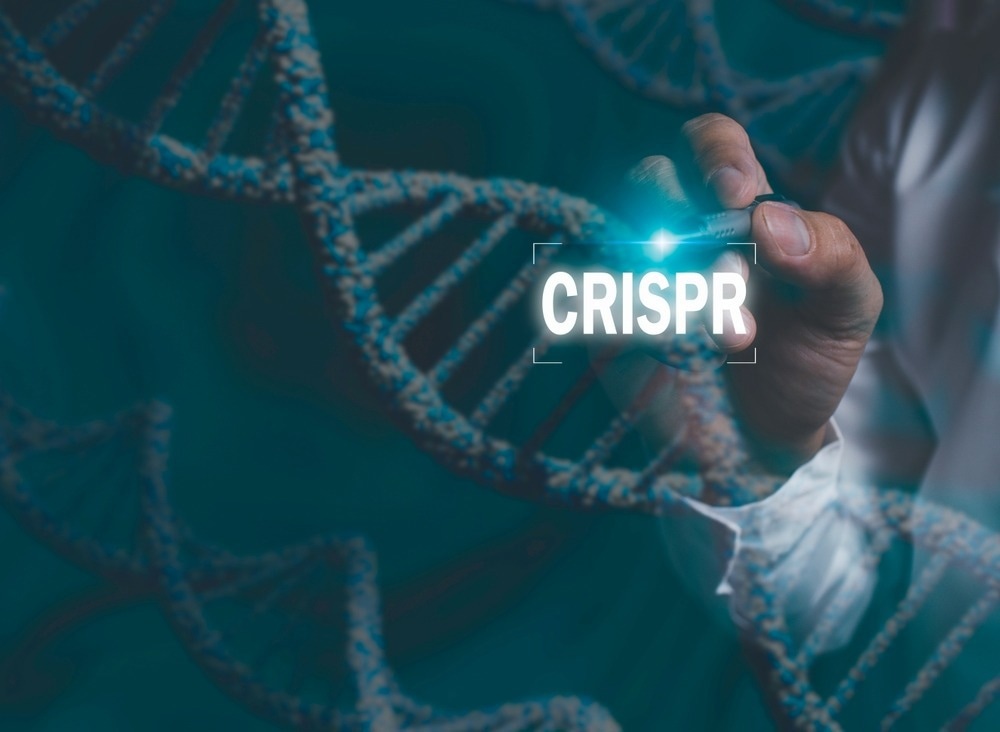The need for targeted drugs
CRISPR/Cas9 in drug discovery
Precision medicine and personalized therapies
Future prospects and conclusions
References
Further reading
Clustered regular interspaced short palindromic repeat/CRISPR-associated 9 (CRISPR/Cas9) is a gene-editing technology that has revolutionized biomedical research since its original publication in 2012. The two primary components involved in CRISPR/Cas9 include a guide ribonucleic acid (RNA) to match a desired target gene and Cas9, which is an endonuclease that causes breaks in double-stranded DNA.

Image Credit: Gohang/Shutterstock.com
Cas9 is directed to its target within the DNA sequence through the use of the guide RNA. A specific sequence of DNA that is between two and five nucleotides in length must align with the 3’ end of the guide RNA in order for the sequence to be cut and replaced by the synthetic single guide RNA (sgRNA). Subsequently, DNA repair pathways like non-homologous end joining (NHEJ) or homology-directed repair bring the Cas9 and sgRNA together to ultimately modify the genome.
The incorporation of CRISPR/Cas9 into clinical settings has promising applications for the future treatment of genetic disorders, human immunodeficiency virus (HIV) infection, and various malignant diseases. Although considerable research is still needed to optimize the targeted delivery of Cas9 molecules into cells and prevent unwanted off-target effects, CRISPR/Cas9 technology has the potential to revolutionize the treatment of many debilitating health conditions.
The need for targeted drugs
Considerable scientific advancements over the past several decades have contributed to the development of novel treatment options that target specific molecular perturbations in different diseases.
Within oncology, the combination of targeted treatments with traditional therapies like chemotherapy, radiation, and/or immunotherapy has significantly increased survival rates while also reducing the risk of undesirable side effects.
Although many targeted anticancer therapies (TATs) are associated with less severe toxicity as compared to standard chemotherapy treatments, they are still associated with their unique adverse effects, some of which include rash, cardiac dysfunction, hypertension, and bleeding.
This necessitates the involvement of toxicity specialists early on in the drug development process to allow drug developers to gain a thorough understanding of a compound’s toxicity and determine how to circumvent it in a timely manner.
In addition to the limitations associated with current targeted therapies, the identification and subsequent development of new targeted agents is also a tedious and expensive process. In fact, current estimates indicate that the time to develop a new anticancer drug is between 12-15 years, with costs reaching up to $2 billion USD.
CRISPR/Cas9 in drug discovery
Within the pharmaceutical industry, drug screening has historically been used to identify chemically synthesized small molecule drugs capable of inducing desired effects in a cell-based disease model. Drug screening often involves large-scale and high-throughput assays that allow researchers to test and compare the in vitro efficacy of numerous molecules simultaneously.
CRISPR technology can be incorporated into drug screening assays for both full and specified genome applications. Often, CRISPR is used to differentially express specific genetic sequences that are relevant to the disease being studied. This creates an in vitro model in which researchers can then evaluate the efficacy and toxicity of various compounds before initiating further in vivo studies.

Image Credit: Gorodenkoff/Shutterstock.com
In addition to this type of hypothesis-driven screen, CRISPR can also be applied to genome-wide screens in which all known genes are targeted in an effort to identify potentially unknown genes involved in the disease phenotype of interest. A restricted CRISPR screen can also be used for drug discovery purposes, in which a specific subset of genes that are relevant to the disease phenotype are explored.
Precision medicine and personalized therapies
Precision medicine incorporates individual differences in patients’ genes, as well as their environments and lifestyles, in order to identify specific treatment options that are most likely to be effective in treating their disease.
Within oncology, for example, cancer patients each have their own unique genetic and epigenetic patterns. Even cancer patients with the same type of cancer will exhibit different transcriptomes, proteomes, and metabolomes, thus causing patients to often respond to the same therapeutic regimen differently.
CRISPR technologies have already been incorporated into the personalized screening of cancers in an effort to identify the presence of certain genes that may contribute to tumor growth, drug resistance, epithelial-to-mesenchymal transition, cancer origins, metabolic adaptations, and metastasis. CRISPR screens have also been performed on patient tissues to identify individualized drug targets and model how they might respond to different therapeutic regimens.
A vast amount of research has also been dedicated to the development of CRISPR therapeutics; however, the efficacy and safety of these treatments are primarily dependent upon their mode of delivery. In various preclinical cancer models, CIRSPR-Cas components have been successfully delivered in the form of plasmids and nanoparticles, as well as both non-viral and viral vectors.
Future prospects and conclusions
Over the past several years, CRISPR and CRISPR-based screens have transformed the drug discovery process to significantly improve the efficacy, safety, and specificity of novel therapeutics. CRISPR technologies can be incorporated into every step of the drug discovery process, beginning with the use of genome-wide screens to identify genes that are important for certain disease phenotypes and even delivering CRISPR-Cas components for therapeutic purposes.
References
- Redman, M., King, A., Watson, C., & King, D. (2016). What is CRISPR/Cas9? Archives of Disease in Childhood, Education and Practice Edition 101(4); 213-215. doi:10.1136/archdischild-2016-310459.
- Iyer, V. S., Jiang, L., Shen, Y., et al. (2020). Designing custom CRISPR libraries for hypothesis-driven drug target discovery. Computational and Structural Biotechnology Journal 18; 2237-2246. doi:10.1016/j.csbj.2020.08.009.
- Keefe, D. M. K., & Bateman, E. H. (2019). Potential Successes and Challenges of Targeted Cancer Therapies. JNCI Monographs 53. doi:10.1093/jncimonographs/lgz008.
- Das, S., Bano, S., Kapse, P., & Kundu, G. C. (2022). CRISPR based therapeutics: a new paradigm in cancer precision medicine. Molecular Cancer 21(85). doi:10.1186/s12943-022-01552-6.
Further Reading
Last Updated: Dec 8, 2023